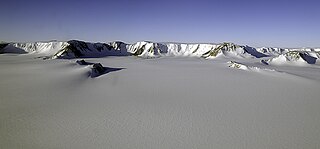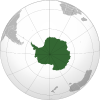Related Research Articles

Mount Erebus is the second-highest volcano in Antarctica, the highest active volcano in Antarctica, and the southernmost active volcano on Earth. It is the sixth-highest peak of an island and the second most prominent mountain in Antarctica after Mount Vinson. It has a summit elevation of 3,794 metres (12,448 ft). It is located in the Ross Dependency on Ross Island, which is also home to three inactive volcanoes: Mount Terror, Mount Bird, and Mount Terra Nova. The mountain was named by Captain James Clark Ross in 1841 for his ship, HMS Erebus.

The Shackleton Range is a mountain range in Antarctica that rises to 1,875 metres (6,152 ft) and extends in an east–west direction for about 100 miles (160 km) between the Slessor and Recovery Glaciers.

The Recovery Glacier is a glacier, at least 60 nautical miles long and 40 nautical miles wide at its mouth, flowing west along the southern side of the Shackleton Range in Antarctica.
Skelton Glacier is a large glacier flowing from the polar plateau into the Ross Ice Shelf at Skelton Inlet on the Hillary Coast, south of Victoria Land, Antarctica.

The Byrd Glacier is a major glacier in Antarctica, about 136 km (85 mi) long and 24 km (15 mi) wide. It drains an extensive area of the Antarctic plateau, and flows eastward to discharge into the Ross Ice Shelf.
The Cook Mountains is a group of mountains bounded by the Mulock and Darwin glaciers in Antarctica. They are south of the Worcester Range and north of the Darwin Mountains and the Britannia Range.

The Darwin Glacier is a large glacier in Antarctica. It flows from the polar plateau eastward between the Darwin Mountains and the Cook Mountains to the Ross Ice Shelf. The Darwin and its major tributary the Hatherton are often treated as one system, the Darwin–Hatherton.

Koettlitz Glacier is a large Antarctic glacier lying west of Mount Morning and Mount Discovery in the Royal Society Range, flowing from the vicinity of Mount Cocks northeastward between Brown Peninsula and the mainland into the ice shelf of McMurdo Sound.

The Herbert Mountains are a conspicuous group of rock summits on the east side of Gordon Glacier in the Shackleton Range of Antarctica. They were first mapped in 1957 by the Commonwealth Trans-Antarctic Expedition and named for Sir Edwin S. Herbert, Chairman of the Finance Committee and a Member of the Committee of Management of the expedition, 1955–58.

Miers Valley is a valley just south of Marshall Valley and west of Koettlitz Glacier, on the coast of Victoria Land, Antarctica. The valley is ice-free except for Miers Glacier in its upper (western) part and Lake Miers near its center. It was mapped and named by Robert Falcon Scott's British Antarctic Expedition, 1910–13. The name is possibly after Edward J. Miers, a marine biologist from the British Museum who examined crustacea from the Erebus and Terror expeditions.

Otter Highlands is a group of peaks and ridges extending northwest-southeast for 17 nautical miles from Mount Lowe to Wyeth Heights, located west of Blaiklock Glacier and forming the west end of the Shackleton Range. Surveyed by the Commonwealth Trans-Antarctic Expedition in 1957. Named by the United Kingdom Antarctic Place-Names Committee (UK-APC) in 1972 after the De Havilland Otter aircraft which supported the CTAE.
Fuchs Dome is a large ice-covered dome rising over 1,525 metres (5,000 ft), between Stratton Glacier and Gordon Glacier in the central part of the Shackleton Range, Antarctica.
Mount Greenfield is an ice-free mountain rising to 1,490 metres (4,890 ft) and surmounting the western extremity of Stephenson Bastion in the Shackleton Range of Antarctica. It was mapped in 1957 by the Commonwealth Trans-Antarctic Expedition (CTAE) and named after George C. Greenfield, a literary agent of the CTAE from 1955 to 1958.
Glen Glacier is a glacier at least 7 nautical miles (13 km) long, flowing south in the Shackleton Range of Antarctica to join Recovery Glacier to the west of the Read Mountains.
The Kirkwood Range is a massive coastal mountain range in Antarctica, extending north–south between Fry Glacier and Mawson Glacier. A broad low-level platform on the seaward side of the range is occupied by the Oates Piedmont Glacier. It is south of the Prince Albert Mountains and northeast of the Convoy Range.
Stephenson Bastion is a mountain massif with steep rock cliffs on its south side, rising to 1,850 metres (6,070 ft) in the south-central part of the Shackleton Range. It was first mapped in 1957 by the Commonwealth Trans-Antarctic Expedition, and it was photographed by U.S. Navy aircraft in 1967. It was named by the United Kingdom Antarctic Place-Names Committee (UK-APC) for Philip J. Stephenson, an Australian geologist with the transpolar party of the CTAE in 1956–58.
Ravens Mountains is a symmetrical group of mountains on the west side of Hughes Basin in Britannia Range, Antarctica. The mountains are 12 nautical miles long and rise to 2,130 metres (6,990 ft) in Doll Peak.

Read Mountains is a group of rocky summits, the highest being Holmes Summit at 1,875 metres (6,152 ft), lying east of Glen Glacier in the south-central part of the Shackleton Range.

La Grange Nunataks is a scattered group of nunataks extending west for 22 nautical miles (41 km) from the mouth of Gordon Glacier, on the north side of the Shackleton Range, Antarctica. They were first mapped in 1957 by the Commonwealth Trans-Antarctic Expedition (CTAE), and were photographed in 1967 by U.S. Navy aircraft. They were named by the UK Antarctic Place-Names Committee for Johannes J. La Grange, a South African meteorologist with the CTAE. Not: Beney Nunataks.
The Lewis Chain is a chain of four rock nunataks on the west side of Gordon Glacier in the Shackleton Range of Antarctica. It was first mapped by the Commonwealth Trans-Antarctic Expedition (CTAE) in 1957, and was photographed by the U.S. Navy in 1967. The chain was named by the UK Antarctic Place-Names Committee for Squadron Leader John H. Lewis, Royal Air Force (RAF), senior pilot of the RAF contingent of the CTAE, 1956–58.
References
- ↑ "Haslop, Mount". Geographic Names Information System . United States Geological Survey, United States Department of the Interior . Retrieved 30 May 2012.
![]() This article incorporates public domain material from "Haslop, Mount". Geographic Names Information System . United States Geological Survey.
This article incorporates public domain material from "Haslop, Mount". Geographic Names Information System . United States Geological Survey.
